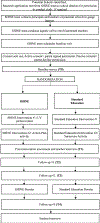Protocol for a cluster-randomized trial of a school-based skin cancer preventive intervention for adolescents
- PMID: 38458557
- PMCID: PMC11065585
- DOI: 10.1016/j.cct.2024.107494
Protocol for a cluster-randomized trial of a school-based skin cancer preventive intervention for adolescents
Abstract
Background: Adolescents infrequently use sun protection and engage in intentional tanning more frequently compared to other age groups, leading to increased ultraviolet radiation (UVR) exposure that heightens skin cancer risk across the lifespan. High schools are therefore an ideal setting for offering skin cancer preventive interventions. Yet, there are limited UVR protection interventions for high school students, especially those that are personalized, tested using randomized designs, and include long-term outcome assessment to determine the durability of intervention effects.
Method: The Sun-safe Habits Intervention and Education (SHINE) cluster-randomized trial will test a novel, personalized intervention that targets high school adolescents' sun protection and tanning behaviors, and tracks their outcomes for up to one year following intervention. Enrolled high schools will be randomized to receive either the personalized SHINE intervention, which includes facial UVR photographs and sun protection action planning, or standard education using publicly available materials. Students in both conditions will receive information about skin cancer, sun protection, and skin self-examination. Outcome variables will include students' sun protection and tanning behaviors and sunburn occurrence. Potential moderators (e.g., race/ethnicity) and mediators (e.g., self-efficacy) will also be assessed and tested.
Conclusions: This trial examines the efficacy of a personalized intervention targeting sun protection and tanning of high school students. The project will lead to new scientific understanding of the theoretical mechanisms underlying outcomes and moderators of the intervention effects, which will inform future intervention tailoring to meet the needs of vulnerable subgroups.
Keywords: Adolescents; Health behavior; Intervention; Prevention; School-based; Skin cancer.
Copyright © 2024 Elsevier Inc. All rights reserved.
Conflict of interest statement
Declaration of competing interest The authors declare that they have no known competing financial interests or personal relationships that could have appeared to influence the work reported in this paper.
Similar articles
-
A four-group experiment to improve Western high school students' sun protection behaviors.Transl Behav Med. 2019 May 16;9(3):468-479. doi: 10.1093/tbm/ibz021. Transl Behav Med. 2019. PMID: 31094440 Free PMC article.
-
The Risk Information and Skin-cancer Education for Undergraduate Prevention (RISE-UP) Study: Protocol for a Trial of Personalized Sun Protection Interventions for Skin Cancer Prevention among Undergraduate Students.Contemp Clin Trials. 2024 Dec;147:107728. doi: 10.1016/j.cct.2024.107728. Epub 2024 Nov 2. Contemp Clin Trials. 2024. PMID: 39491719
-
Knowledge and attitudes of UK university students in relation to ultraviolet radiation (UVR) exposure and their sun-related behaviours: a qualitative study.BMJ Open. 2017 Mar 13;7(3):e014388. doi: 10.1136/bmjopen-2016-014388. BMJ Open. 2017. PMID: 28289050 Free PMC article.
-
Prevalence of sunburn, sun protection, and indoor tanning behaviors among Americans: review from national surveys and case studies of 3 states.J Am Acad Dermatol. 2011 Nov;65(5 Suppl 1):S114-23. doi: 10.1016/j.jaad.2011.05.033. J Am Acad Dermatol. 2011. PMID: 22018060 Review.
-
Encouraging sun protection early in life: from a successful prevention programme in children to the identification of psychological barriers in adolescents.J Eur Acad Dermatol Venereol. 2022 Jun;36 Suppl 6:12-21. doi: 10.1111/jdv.18194. J Eur Acad Dermatol Venereol. 2022. PMID: 35738808 Review.
References
-
- US Department of Health and and Human Services, The Surgeon General’s call to action to prevent skin cancer. 2014: Washington, DC: Department of Health and Human Services.
-
- American Academy of Dermatology. Prevent skin cancer. 2017. [cited 2017 July 11]; Available from: https://www.aad.org/public/spot-skin-cancer/learn-about-skin-cancer/prevent.
-
- Gallagher RP, et al., Sunlight exposure, pigmentary factors, and risk of nonmelanocytic skin cancer: I. Basal cell carcinoma. Arch Dermatol, 1995. 131(2): p. 157–163. - PubMed
-
- Balk SJ, Ultraviolet radiation: A hazard to children and adolescents. Pediatrics, 2011. 127(3): p. e791–e817. - PubMed
Publication types
MeSH terms
Substances
Grants and funding
LinkOut - more resources
Full Text Sources
Medical


